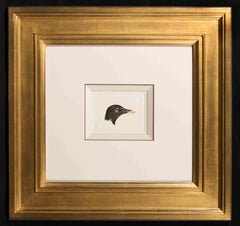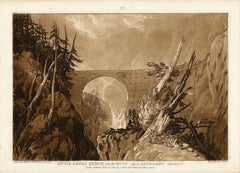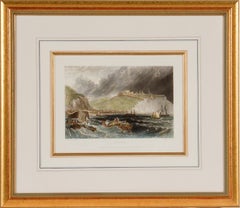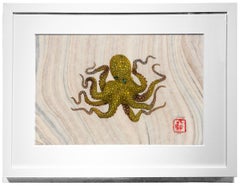Joseph Mallord William Turner Art
to
1
1
2
1
1
Study of the Head of a Moorhen
By Joseph Mallord William Turner
Located in Belgravia, London, London
Watercolour on paper
Paper size: 4 x 5 inches
Framed size: 19 x 19.75 inches
PROVENANCE
A gift from Joseph Mallord William Turner to Miss Amelia Hawksworth (later Mrs Hotham), niece of Walter Fawkes. The watercolour descended through the ownership of Amelia Hawksworth, daughter of Francis Fawkes ( Walter Fawkes's brother) who was the main compiler of the Ornithological Collection (Miss Hawksworth owned five other bird studies by Turner).
Private collection, London
LITERATURE:
For similar works by J M W Turner see Anne Lyles, The Tate catalogue for the exhibition 'Turner and Natural History, The Farnley Project', 1988.
The present watercolour was drawn circa 1815-1820 for Walter Fawkes of Farnley Hall, for his Ornithological Collection Volume IV.
Between 1808 and 1824, Turner visited Farnley Hall in Yorkshire to stay with the Fawkes family. Turner felt at home at Farnley - the Fawkes daughters reminded him of his own. He helped illustrate a five volume ornithological scrap book for the Fawkes children, making watercolour studies of the birds for the children to stick in opposite the pages on which feathers from similar birds were attached. His bird portraits were most effective, most "life-like", when in fact the bird was dead ! His watercolours of a live robin and goldfinch have a more hesitant touch.
At this time Turner enjoyed the patronage first of Edward Lascelles, the heir to Harewood, and after 1808, of the radical landlord Walter Fawkes of Farnley Hall, near Otley. He became a close friend of the Fawkes family with whom he stayed for most summers until 1824.
The last owner of Old Farnley Hall was Francis Fawkes, a rich widower with no direct heirs. When Francis Fawkes died in 1786 he left the house to Walter Beaumont Hawksworth of Hawksworth Hall, on condition that Hawksworth adopt the Fawkes name by Royal Licence. Walter Fawkes brought in architect John Carr of York to make extensions to the house, but he died before the work was completed, and Farnley Hall was passed on to his son, also called Walter who also took the Fawkes name and was known as Walter Ramsden Fawkes. It was this Walter who was a great friend of J M W Turner.
Anne Lyles has confirmed the attribution and writes:
"Everything fits in relation to the style of the watercolour and most especially the provenance - in the Turner and Natural History exhibition catalogue of 1988 we know that Amelia Hawksworth (Mrs Hotham) owned three studies of birds' heads by J M W Turner (previously with the Maas Gallery, and numbers 36, 37 and 61 in that catalogue) as well as two studies of dead game by the artist (catalogue numbers 59 and 63, the latter untraced in 1988). Interestingly, catalogue numbers 36 and 37 (the Merganser and the Smew) seem also originally to have been intended for Volume IV of the Ornithological Collection - it is likely that the "Study of the Head of a Moorhen...
Category
19th Century Joseph Mallord William Turner Art
Materials
Paper, Watercolor
Little Devils Bridge over the Russ, above Alt Dorft Swiss
By Joseph Mallord William Turner
Located in Fairlawn, OH
Little Devils Bridge over the Russ, above Alt Dorft Swiss
From: Liber Studiorum
Etching and mezzotint, 1809
Signed in the plate by JMW Turner and Charles Turner who applied the mezz...
Category
Early 1800s Romantic Joseph Mallord William Turner Art
Materials
Mezzotint
Related Items
A View of Dover, England: A Framed 19th C. Engraving After J. M. W. Turner
By J.M.W. Turner
Located in Alamo, CA
This beautiful 19th century framed engraving "Dover" by Thomas Lupton is based on an original painting by the renowned British artist J.M.W. Turner, which depicts a panoramic view of the harbor of Dover, a town in southeastern England, that has been an important port for centuries. The engraving captures the dramatic sky and sea that Turner was known for, with billowing clouds and waves crashing against the shore. The town and its famous white cliffs are visible in the background, while ships and boats dot the harbor in the foreground. Several wooden rowboats...
Category
Mid-19th Century Romantic Joseph Mallord William Turner Art
Materials
Engraving
$460 Sale Price
20% Off
H 18 in W 20.5 in D 1 in
Lemon Meringue - Gyotaku Style Sumi Ink Painting of a Multi-Colored Octopus
By Jeff Conroy
Located in Chicago, IL
A small octopus is inked in the Japanese style of Gyo-Taku print making. Using sumi ink to "print" the octopus, the artist then embellishes it with colored pencil to convey an extraordinary dimensionality. By printing it on Mulberry paper, which mimics the swirl of water, the artist achieves a beautiful aesthetic. The artwork is matted and framed in a simple white wooden frame measuring 18.25h x 24.25w x 1d inches.
Jeff Conroy
Lemon Meringue
sumi ink and colored pencil on mulberry paper
12.50h x 18.25w in
31.75h x 46.35w cm
JEC118
Gyotaku - A Japanese word translated from "gyo" meaning fish and "taku" meaning stone impression and is believed to get its inspiration from Chinese stone rubbings...
Category
21st Century and Contemporary Contemporary Joseph Mallord William Turner Art
Materials
Sumi Ink, Watercolor, Mulberry Paper, Color Pencil
$975
H 12.5 in W 18.25 in
Spider Lily: An Original 18th C. Hand-colored Botanical Engraving by J. Weinmann
By Johann Wilhelm Weinmann
Located in Alamo, CA
This colored botanical mezzotint and line engraving finished with hand coloring by Johann Wilhelm Weinmann (1683-1741) is entitled "A. Ephemerum Virginianu flore Purpureo, B. Ephemer...
Category
Mid-18th Century Naturalistic Joseph Mallord William Turner Art
Materials
Engraving, Mezzotint
$620 Sale Price
20% Off
H 15.75 in W 9.5 in
Flowering Sweet Pea: 18th Century Hand-colored Botanical Engraving by Weinmann
By Johann Wilhelm Weinmann
Located in Alamo, CA
This is an original antique colored botanical mezzotint and line engraving of flowering Red Sweet Peas which is finished with hand-coloring. It is entitled "Lathyrus Flore Majore Pur...
Category
Mid-18th Century Naturalistic Joseph Mallord William Turner Art
Materials
Engraving, Mezzotint
$540 Sale Price
20% Off
H 15.25 in W 10 in
String of Pearls - Gyotaku Style Sumi Ink Painting of an Octopus, Framed
By Jeff Conroy
Located in Chicago, IL
A small octopus is inked in the Japanese style of Gyo-Taku print making. Using sumi ink to "print" the octopus, the artist then embellishes it with colored pencil to convey an extraordinary dimensionality. By printing it on hand-made Mulberry paper, in this case a paper that mimics the undulating patterns of water, the artist achieves a beautiful aesthetic. The artwork is matted and framed in a white wooden frame measuring 18.25h x 24.25w x 1d inches.
Jeff Conroy
String of Pearls
sumi ink and colored pencil on mulberry paper
12.50h x 18.50w in
31.75h x 46.99w cm
JEC126
Gyotaku - A Japanese word translated from "gyo" meaning fish and "taku" meaning stone impression and is believed to get its inspiration from Chinese stone...
Category
21st Century and Contemporary Contemporary Joseph Mallord William Turner Art
Materials
Sumi Ink, Watercolor, Mulberry Paper, Color Pencil
$975
H 12.5 in W 18.5 in
Goldilocks, Pastel - Gyotaku Style Sumi Ink Painting of an Octopus
By Jeff Conroy
Located in Chicago, IL
A small octopus is inked in the Japanese style of Gyotaku print making. Using sumi ink to "print" the octopus, the artist then embellishes it with colored pe...
Category
21st Century and Contemporary Contemporary Joseph Mallord William Turner Art
Materials
Sumi Ink, Watercolor, Mulberry Paper, Color Pencil
Chrysanthemum: An 18th Century Hand-colored Botanical Engraving by J. Weinmann
By Johann Wilhelm Weinmann
Located in Alamo, CA
This is an original antique hand-colored botanical mezzotint and line engraving of flowering Chrysanthemum matricaria plants. It is entitled "A. Chrysanthemum Matricarice Folus Flore...
Category
Mid-18th Century Naturalistic Joseph Mallord William Turner Art
Materials
Engraving, Mezzotint
$700 Sale Price
20% Off
H 15.75 in W 9.75 in
Flowering Pea Plant: An 18th C. Hand-colored Botanical Engraving by J. Weinmann
By Johann Wilhelm Weinmann
Located in Alamo, CA
This hand-colored botanical mezzotint and line engraving by Johann Wilhelm Weinmann (1683-1741) is entitled "A. Lathyrus Major Peremis Richern B. Lathyrus Narbonensis Flore Albescen...
Category
Mid-18th Century Naturalistic Joseph Mallord William Turner Art
Materials
Engraving, Mezzotint
$540 Sale Price
20% Off
H 15.75 in W 9.63 in
Fishing Off Hastings, England: A Framed 19th C. Engraving After J. M. W. Turner
By J.M.W. Turner
Located in Alamo, CA
This beautiful 19th century framed engraving "Line Fishing Off Hastings" by William Miller is based on an original painting by the renowned British artist J.M.W. Turner, which depicts a scene of fishermen at work off the coast of the town of Hastings in East Sussex, England. The Miller engraving faithfully reproduces Turner's painting, capturing the same atmospheric quality and sense of motion. In the foreground of the image, a group of fishermen are shown in a small boat, with one man using a fishing line to catch fish. In the background, there is a larger ship, along with a view of the town of Hastings and the cliffs beyond. Overall, the Miller engraving "Line Fishing Off Hastings" is a beautiful and detailed representation of Turner's original painting, and provides a glimpse into life in a 19th century fishing community.
This colorful 19th century engraving is presented in a gold-colored wood frame and a cream-colored French mat highlighted with a light blue band and thinner mustard and gold-colored bands. There is a gold-colored fillet which further embellishes the engraving. The frame measures 18" high, 20.5" wide and 1" deep. The engraving, frame and mat are in excellent condition.
Joseph Mallord William (J.M.W.) Turner (1775-1851) was an English painter who is widely considered one of the greatest landscape painters in Western art history. Born in London, he showed a remarkable talent for art from a young age, and studied at the Royal Academy of Arts from the age of 14. He quickly gained recognition for his watercolor landscapes, which were highly innovative and expressive. Turner's style evolved over time, and he became increasingly interested in the effects of light and color. He traveled extensively throughout Europe, and his experiences of the natural world, particularly the sea and the sky, had a profound influence on his art. His paintings are known for their luminosity, atmospheric effects, and dramatic use of color. Despite facing criticism and ridicule from some of his contemporaries, Turner continued to push the boundaries of art, experimenting with new techniques and styles throughout his career. He was a prolific artist, creating thousands of paintings, sketches, and watercolors, and his legacy continues to inspire artists today.
William Miller (1796-1882) was an English engraver and publisher, best known for his work in reproducing the paintings of J.M.W. Turner. Miller was born in Bristol and began his career as an engraver at a young age, working for a variety of publications and artists. In the early 1820s, Miller began working with Turner, engraving many of the artist's most famous works, including "The Fighting Temeraire...
Category
Mid-19th Century Romantic Joseph Mallord William Turner Art
Materials
Engraving
$460 Sale Price
20% Off
H 18 in W 20.5 in D 1 in
The Fighting Temeraire: A Framed 19th C. Engraving After J. M. W. Turner
By J.M.W. Turner
Located in Alamo, CA
This beautiful 19th century framed engraving "The Fighting Temeraire" by James Tibbetts Willmore is based on an original painting by the renowned British artist J.M.W. Turner. It was published by James S. Virtue & Co. in London between 1859-1875. It depicts the once mighty British warship the HMS Temeraire being towed away down the river Thames by a much smaller steamboat to a ship-breaking yard to be broken up for scrap. The Temeraire was first launched in 1798 and represented the pinnacle of British ship-building. 180-feet long, constructed of English oak and armed with 98 guns, she was one of the largest warships of the period. The Temeraire became a symbol of British pride and military power that endured throughout the 19th century. The man-of-war served during the French Revolutionary and Napoleonic Wars and was among the last serving ships to have been at the Battle of Trafalgar in 1805. It became one of the many older ships put out of service in the 1830s and 1840s. The once mighty and feared ship symbolizes a once magnificent, but now obsolete, technology. Turner seems to lament her inglorious final journey, being towed by a less magnificent, but modern steam powered tugboat.
The Turner painting was created in 1838 and is now held in the National Gallery in London. Willmore's engraving, created in 1859, captures the dramatic scene with great detail and skill. The image has become an iconic representation of the decline of Britain's naval power and the transition from sail to steam in the 19th century. The sunset in the background is symbolic of the sun going down on British naval power and tradition. The painting conveys profound and diverse themes that are central to the human experience: those of mortality and change, technology and progress, heroism and brutality. The painting demonstrates Turner’s skill as an artist. His ability to produce scenes of great beauty that are dramatic, but are also symbolic, stimulating both thoughtful analysis, as well as emotion. Turner's painting was voted by the British public in a 2005 BBC radio sponsored survey to be the British people's favorite painting of all time. In 2020 it was included on a new British banknote...
Category
Mid-19th Century Romantic Joseph Mallord William Turner Art
Materials
Engraving
$540 Sale Price
20% Off
H 18 in W 20.5 in D 1 in
The French Rooster
By Raymond Debieve
Located in London, GB
'The French Rooster', gouache on art paper, by Raymond Debiève (circa 1960s). A Mid-Century modern depiction of the French coq, or rooster. The origin o...
Category
1960s Modern Joseph Mallord William Turner Art
Materials
Paper, Gouache
Cobalt Canary - Gyotaku Style Sumi Ink Painting, Multi-Colored Octopus, Framed
By Jeff Conroy
Located in Chicago, IL
A small octopus is inked in the Japanese style of Gyo-Taku print making. Using sumi ink to "print" the octopus, the artist then embellishes it with colored pencil to convey an extraordinary dimensionality. By printing it on Mulberry paper, which mimics the swirl of water, the artist achieves a beautiful aesthetic. The artwork is matted and framed in a white wooden frame measuring 18.25h x 24.25w x 1d inches.
Jeff Conroy
Cobalt Canary
sumi ink and colored pencil on mulberry paper
12.50h x 18.25w in
31.75h x 46.35w cm
JEC122
Gyotaku - A Japanese word translated from "gyo" meaning fish and "taku" meaning stone impression and is believed to get its inspiration from Chinese stone rubbings...
Category
21st Century and Contemporary Contemporary Joseph Mallord William Turner Art
Materials
Sumi Ink, Watercolor, Mulberry Paper, Color Pencil
$975
H 12.5 in W 18.25 in
Joseph Mallord William Turner art for sale on 1stDibs.
Find a wide variety of authentic Joseph Mallord William Turner art available for sale on 1stDibs. You can also browse by medium to find art by Joseph Mallord William Turner in engraving, mezzotint, paint and more. Not every interior allows for large Joseph Mallord William Turner art, so small editions measuring 16 inches across are available. Customers who are interested in this artist might also find the work of Alfred Munnings, Thomas Sidney Cooper, and Laurence Stephen Lowry. Joseph Mallord William Turner art prices can differ depending upon medium, time period and other attributes. On 1stDibs, the price for these items starts at $1,850 and tops out at $179,627, while the average work can sell for $90,738.



